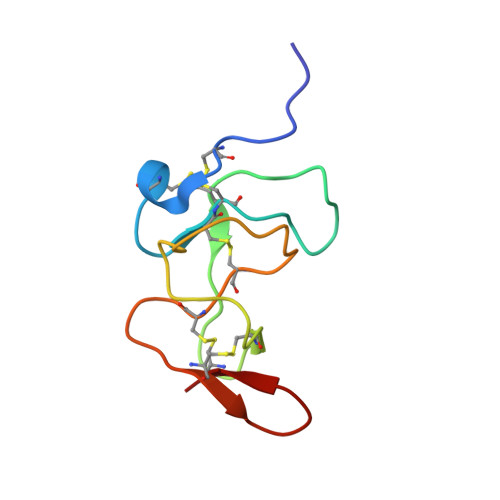Chemical synthesis and structure of the prokineticin Bv8
Morales, R.A.V., Daly, N.L., Vetter, I., Mobli, M., Napier, I.A., Craik, D.J., Lewis, R.J., Christie, M.J., King, G.F., Alewood, P.F., Durek, T.(2010) Chembiochem 11: 1882-1888
- PubMed: 20677202
- DOI: https://doi.org/10.1002/cbic.201000330
- Primary Citation of Related Structures:
2KRA - PubMed Abstract:
Bv8, a 77-residue protein isolated from frogs, is the prototypic member of the prokineticin family of cytokines. Prokineticins (PKs) have only recently been identified in vertebrates (including humans), and they are believed to be involved in a number of key physiological processes, such as angiogenesis, neurogenesis, nociception, and tissue development. We used a combination of Boc solid-phase peptide synthesis, native chemical ligation, and in vitro protein folding to establish robust chemical access to this molecule. Synthetic Bv8 was obtained in good yield and exhibited full activity in a human neuroblastoma cell line and rat dorsal root ganglion (DRG) neurons. The 3D structure of the synthetic protein was determined by using NMR spectroscopy and it was found to be homologous with that of mamba intestinal toxin 1, which is the only other known prokineticin structure. Analysis of a truncated mutant lacking five residues at the N terminus that are critical for receptor binding and activation showed no perturbation to the core protein structure. Together with the functional data, this suggests that receptor binding is likely to be a highly cooperative process possibly involving major allosterically driven structural rearrangements. The facile and efficient synthesis presented here will enable preparation of unique chemical analogues of prokineticins, which should be powerful tools for modulating the structure and function of prokineticins and their receptors, and studying the many physiological processes that have been linked to them.
- Institute for Molecular Bioscience, The University of Queensland, 306 Carmody Road, St. Lucia, Brisbane, Australia.
Organizational Affiliation:
















